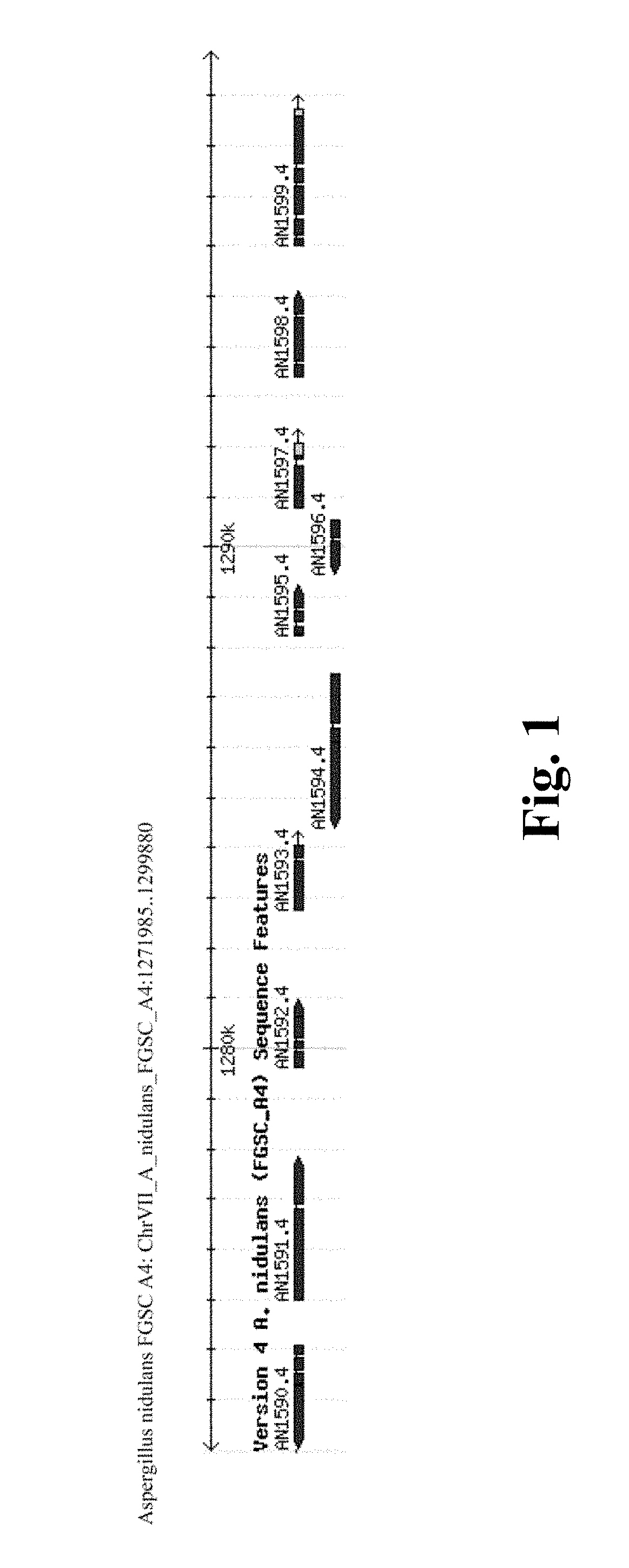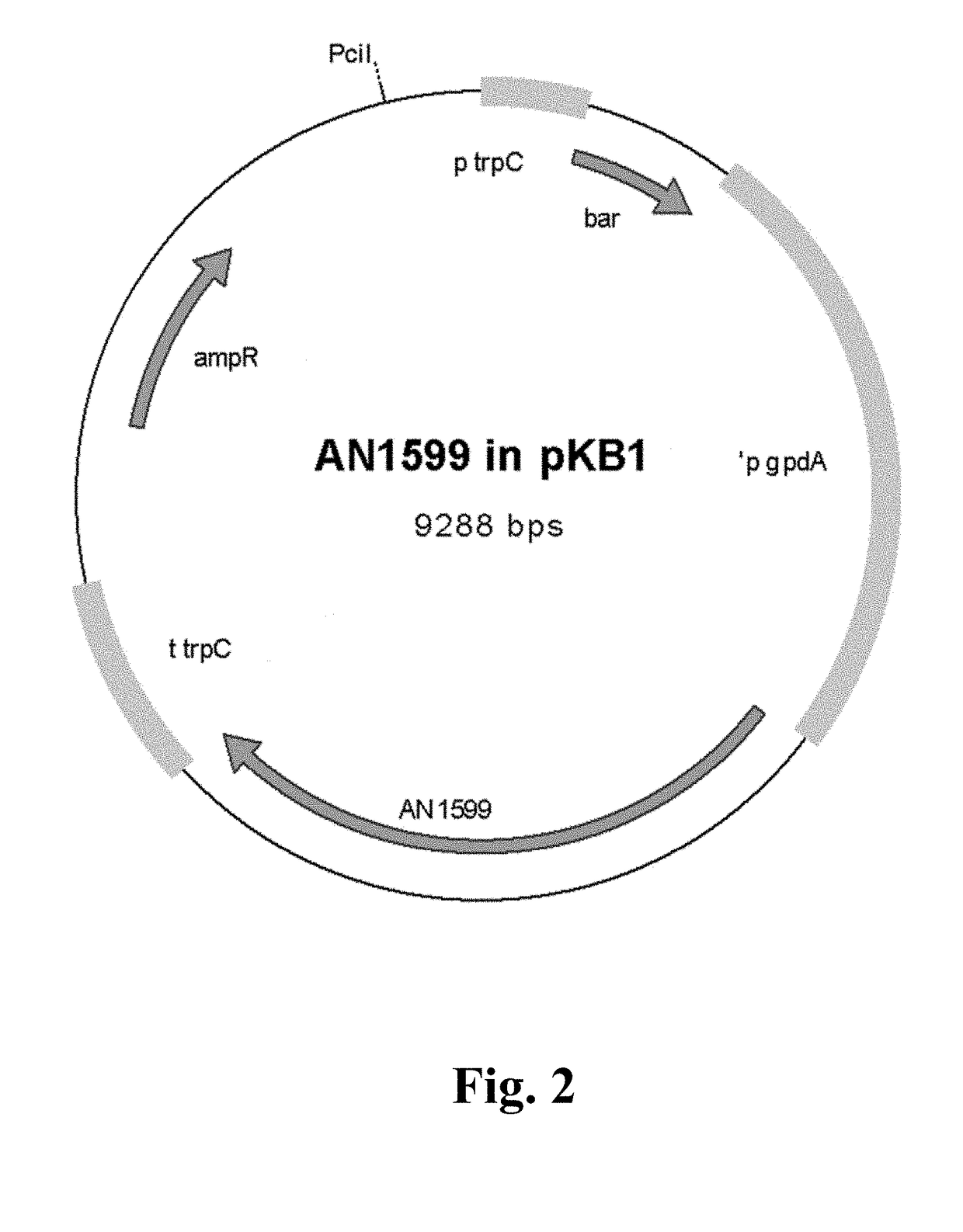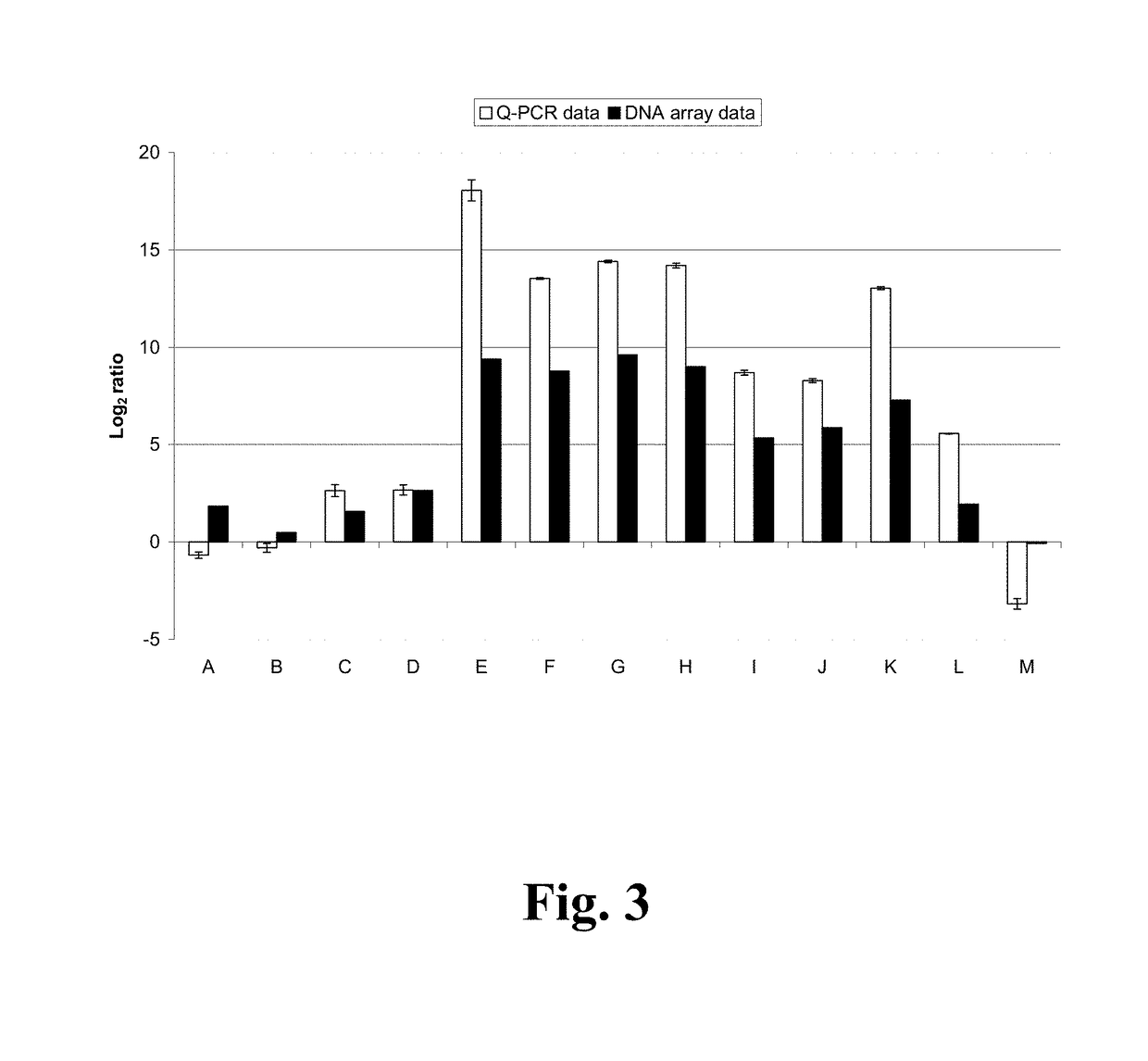Method for producing terpenes
a technology of terpenes and terpenes, which is applied in the field of producing terpenes, can solve the problems of low product outcome or side product production, failure to teach the replacement of certain genes of the cluster, and none of the cited publications disclose the overexpression of a transcription factor specifically activating a cluster, so as to achieve the effect of simultaneously delivering the produ
- Summary
- Abstract
- Description
- Claims
- Application Information
AI Technical Summary
Benefits of technology
Problems solved by technology
Method used
Image
Examples
example 2
f the Fungal Expression Vector for the Transcription Factor AN1599
[0160]Genomic DNA was extracted by homogenizing 300-500 mg of FGSC A4 mycelia grown over night in YES-medium. 500 μL of glass beads (Acid-washed glass beads, cat #G8772, Sigma), 500 μL 1×TE-buffer, pH 7.5 and 500 μL phenol-chloroform-isoamyl alcohol was added to 2 mL vial with mycelia and homogenized in Fast Prep-homogenizer at speed 6 for 25 seconds. Aqueous layer was separated with 5 minute centrifugation at 15 000 rpm at 4° C., and 650 μL of phenol-chloroform-isoamyl alcohol was added. DNA purification from the aqueous phase was continued according to phenol extraction and ethanol precipitation of DNA-protocol (Current Protocols in Molecular Biology). Concentration of the DNA was measured with Nanodrop (Thermo Scientific).
[0161]Open reading frame (ORF) of AN1599 (SEQ ID NO: 1) was amplified with PCR using 43 ng of genomic DNA extracted from Aspergillus nidulans FGSC A4 as template. Primer concentration was 300 nM f...
example 3
g the AN1599 Transformant Strains
[0164]Conidia of Aspergillus nidulans strain FGSC A4 Glasgow wild type (veA+) (Fungal Genetics Stock Center, School of Biological Sciences, University of Missouri, Kansas City, 5007 Rockhill Road, Kansas City, Mo. 64110, USA) were inoculated in YES-medium [20 g Bacto™ Yeast Extract (Cat #212750, Becton, Dickinson and Company), 40 g sucrose (Calbiochem Cat #573113) and 30 g Difco™ Gelatin (Cat #214340, Becton, Dickinson and Company) per liter of dH2O] and grown at +24° C. in shaking flasks over night with 250 rpm. FGSC A772 (galD5; pyrG89; acrA1; chaA1) was grown in YES-medium supplemented with 10 mM uracil and 10 mM uridine at +37° C. in shaking flasks over night with 250 rpm. Aspergillus nidulans FGSC A4 and A772 mycelium was filtered through sterile Miracloth, and rinsed with +37° C. dH2O, and room temperature citrate buffer [0.8 M KCl, 0.05 M Na-citrate, pH 5.8]. Filtrated FGSC A4 mycelium was resuspended in 100 mL of room temperature citrate buff...
example 4
n Analysis of AN1599 Transformant Strain in FGSC A4 Background
[0170]Expression of 13 genes in the genomic area of AN1599 was quantified with qPCR in Aspergillus nidulans AN1599 transformant and FGSC A4 to see which of the genes respond to the over-expression of the transcription factor. AN1599 transformant and FGSC A4 were grown to confluency in YES-media in shaking flasks at +30° C. 250 rpm. Mycelium was harvested to sterile Miracloth (#475855, Calbiochem) by vacuum filtration, rinsed with +37° C. dH2O, and three 100 μL batches of each culture were scooped into 1.5 mL microfuge tubes, flash frozen in liquid nitrogen and stored at −80° C. until RNA extraction.
[0171]Three RNA extractions were done from each transformant culture to have statistical variation within the sample preparation. RNA was extracted from 100 μL of frozen mycelium, which was homogenized in 450 μL RLT-buffer (RNeasy® Plant Mini Kit, Cat #74904, Qiagen) supplemented with b-mercaptoethanol using pestle and motor mi...
PUM
| Property | Measurement | Unit |
|---|---|---|
| pH | aaaaa | aaaaa |
| pH | aaaaa | aaaaa |
| volume | aaaaa | aaaaa |
Abstract
Description
Claims
Application Information
 Login to View More
Login to View More - R&D
- Intellectual Property
- Life Sciences
- Materials
- Tech Scout
- Unparalleled Data Quality
- Higher Quality Content
- 60% Fewer Hallucinations
Browse by: Latest US Patents, China's latest patents, Technical Efficacy Thesaurus, Application Domain, Technology Topic, Popular Technical Reports.
© 2025 PatSnap. All rights reserved.Legal|Privacy policy|Modern Slavery Act Transparency Statement|Sitemap|About US| Contact US: help@patsnap.com



